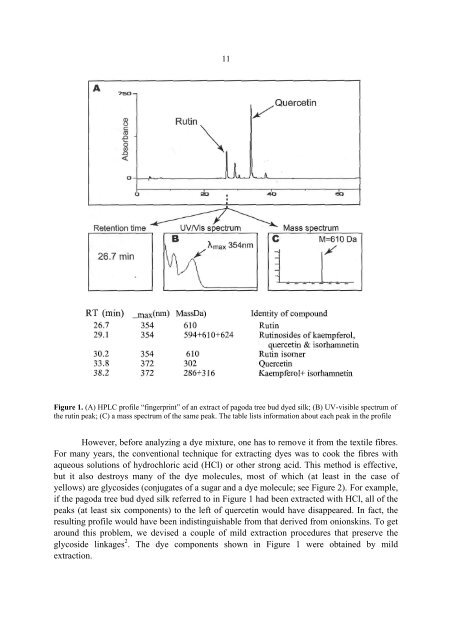10WHAT’S IN A NAME?CREATING A DYESTUFF ANALYSIS DATABASEThe identification of dyes used to colour textiles of historical interest can provideseveral kinds of information. For a conservator, it can guide attempts at restoration and candistinguish between naturally dyed fibres and later restorations (or fakes) made with yarnsand threads dyed with synthetics, which were introduced in about 1860. For thearchaeologist, identification of the dye and of the dyestuff (plant or animal) that produced itcan give clues to the resources and technologies available to the peoples who made thetextiles1. As described below, such knowledge can also be useful to dyers trying to resurrectforgotten traditional methods.About five years ago when we first became interested in natural textile dyes, mygraduate student, Xian Zhang, and I conceived the idea of creating an on-line compilation ofanalytical data on dyestuffs that would be available to whomever was interested in suchinformation. This idea grew out of two technological advances in the field of dye analysis: (1)the availability of new analytical instrumentation, HPLC-DAD-MS, and (2) new methods forextracting dyes from textile samples 2 . High performance Liquid Chromatography (HPLC) isa technique for separating complex mixtures of organic molecules, such as dyes. The mixtureof dyes is pumped through a steel column, about 2 mm in diameter by 15 cm long, containingthe separating medium-usually small beads of silica coated with hydrocarbon molecules.After the separated molecules emerge from the column, their ultraviolet and visible spectralcharacteristics (i.e., colours) are measured as they pass through a diode array detector (DAD) andtheir molecular weights (masses) are determined as they pass into a mass spectrometer(MS). Instrumentation for HPLC-DAD-MS has been used for chemical analysis for severalyears, but at the time we began our work, it had not been used systematically for the analysis ofdyes.With HPLC-DAD-MS, it becomes possible to characterize dye molecules in terms ofthree unrelated criteria: elution time (the time required for each molecule to pass through theseparating medium—a characteristic related to its solubility properties), UV-Visiblespectrum, and molecular mass (e.g., solubility, colour and size). Since a particular dyestuff(most of which are plants) may contain up to a dozen or so dye components, one can thenobtain a detailed “fingerprint” for each dyestuff, as well as detailed information about eachcomponent in the fingerprint. From such analyses, one can quickly amass an enormousamount of data. For example, a single plant dyestuff with an elution profile of 10 peaks givesat least 10 UV-Visible spectra and 10 mass spectra. That is about 2000 spectra for 100dyestuffs. We have over 200 dyestuffs in our own collection, and that is only a fraction ofthose known. Figure 1 shows a “fingerprint” of an extract from silk dyed with flower buds ofthe pagoda tree (Sophora japonica), along with some of the information that can be obtainedby the technique of HPLC-DAD-MS. Pagoda tree buds were commonly used in China andJapan to produce a yellow dye, which was reserved for the Emperor and his court. In fact, atvarious times in both the East and West, commoners were not allowed to wear any colouredclothing at all.
11Figure 1. (A) HPLC profile “fingerprint” of an extract of pagoda tree bud dyed silk; (B) UV-visible spectrum ofthe rutin peak; (C) a mass spectrum of the same peak. The table lists information about each peak in the profileHowever, before analyzing a dye mixture, one has to remove it from the textile fibres.For many years, the conventional technique for extracting dyes was to cook the fibres withaqueous solutions of hydrochloric acid (HCl) or other strong acid. This method is effective,but it also destroys many of the dye molecules, most of which (at least in the case ofyellows) are glycosides (conjugates of a sugar and a dye molecule; see Figure 2). For example,if the pagoda tree bud dyed silk referred to in Figure 1 had been extracted with HCl, all of thepeaks (at least six components) to the left of quercetin would have disappeared. In fact, theresulting profile would have been indistinguishable from that derived from onionskins. To getaround this problem, we devised a couple of mild extraction procedures that preserve theglycoside linkages 2 . The dye components shown in Figure 1 were obtained by mildextraction.
















